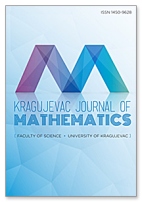On Equienergetic, Hyperenergetic and Hypoenergetic Graphs
 Download PDF
Download PDF
Authors: S. K. VAIDYA AND K. M. POPAT
DOI: 10.46793/KgJMat2004.523V
Abstract:
The eigenvalue of a graph G is the eigenvalue of its adjacency matrix and the energy E(G) is the sum of absolute values of eigenvalues of graph G. Two non-isomorphic graphs G1 and G2 of the same order are said to be equienergetic if E(G1) = E(G2). The graphs whose energy is greater than that of complete graph are called hyperenergetic and the graphs whose energy is less than that of its order are called hypoenergetic graphs. The natural question arises: Are there any pairs of equienergetic graphs which are also hyperenergetic (hypoenergetic)? We have found an affirmative answer of this question and contribute some new results.
Keywords:
Equienergetic, hyperenergetic, hypoenergetic.
References:
[1] R. Balakrishnan and K. Ranganathan, A Textbook of Graph Theory, Springer, New York, 2000.
[2] V. Brankov, D. Stevanović and I. Gutman, Equienergetic chemical trees, Journal of the Serbian Chemical Society 69 (2004), 549–553.
[3] D. M. Cvetković and I. Gutman, The algebraic multiplicity of the number zero in the spectrum of a bipartite graph, Mat. Vesnik (Beograd) 9 (1972), 141–150.
[4] D. M. Cvetković and I. Gutman, The computer system graph: a useful tool in chemical graph theory, J. Comput. Chem. 7 (1986), 640–644.
[5] D. M. Cvetković, P. Rowlison and S. Simić, An Introduction to the Theory of Graph Spectra, Cambridge University Press, Cambridge, 2010.
[6] I. Gutman, The energy of a graph, Ber. Math. Statist. Sekt. Forschungszentrum Graz 103 (1978), 1–22.
[7] I. Gutman, Hyperenergetic molecular graphs, Journal of the Serbian Chemical Society 64 (1999), 199–205.
[8] I. Gutman, Open problems for equienergetic graphs, Iranian Journal of Mathematical Chemistry 6 (2015), 185–187.
[9] I. Gutman, S. Z. Firoozabadi, J. A. de la Pe a and J. Rada, On the energy of regular graphs, MATCH Commun. Math. Comput. Chem. 57 (2007), 435–442.
a and J. Rada, On the energy of regular graphs, MATCH Commun. Math. Comput. Chem. 57 (2007), 435–442.
[10] X. Li, Y. Shi and I. Gutman, Graph Energy, Springer, New York, 2012.
[11] O. Milijković, B. Furtula, S. Radenković and I. Gutman, Equienergetic and almost equienergetic trees, MATCH Commun. Math. Comput. Chem. 61 (2009), 451–461.
[12] H. S. Ramane, I. Gutman, H. B. Walikar and S. B. Halkarni, Equienergetic complement graphs, Kragujevac J. Math. 27 (2005), 67–74.
[13] H. S. Ramane, H. B. Walikar, S. B. Rao, B. D. Acharya, P. R. Hampiholi, S. R. Jog and I. Gutman, Equienergetic graphs, Kragujevac J. Math. 26 (2004), 1–22.
[14] S. K. Vaidya and K. M. Popat, Energy of m-splitting and m-shadow graphs, Far East Journal of Mathematical Sciences 102 (2017), 1571–1578.
[15] S. K. Vaidya and K. M. Popat, Some new results on energy of graphs, MATCH Commun. Math. Comput. Chem. 77 (2017), 589–594.
[16] H. B. Walikar, H. S. Ramane and P. Hampiholi, On the energy of a graph, in: R. Balakrishnan, H. M. Mulder, A. Vijayakumar (Eds.), Graph Connections, Allied Publishers, New Delhi, 1999, 120–123.
